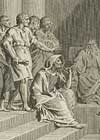Precursors
In the course of the nineteenth century, European interest in secret societies not only expanded across countries due to the blossoming of ethnography, but also in time, with new disciplines such as the history of religion discovering a rich past. Egyptian, Greek, and other ancient 'mystery religions' attracted much attention, being linked to a long literary-utopian tradition. One remarkable example was the organization of the Pythagoreans, legendary already in Antiquity, as painted by Sylvain Maréchal (1750-1803). In 1796 this poet had been involved in the conspiracy of Gracchus Babeuf against the Directory, which tried to get political affairs in France on a new track after the fall of Robespierre. At the end of his imaginary tale of the voyages of Pythagoras written a few years later, Maréchal has the Greek philosopher summarize the rules of his school, in which secrecy was always highly valued. The first and last law of our association, Pythagoras says, is the return to the original state when everything was held in common - thus formulating the very principle of Babeuf's program.
Old, yet non-imaginary tales of travel also proved of sudden interest. Olfert Dapper (1635?-1689), of Amsterdam, for instance, writing about the kingdom of Kquoja in present-day Sierra Leone, was the first one to mention the secret societies of men and women that are known as Poro and Sande. Not every anthropologist is happy with the use of the term 'secret society' in this context, but the tradition is stubborn. Dapper himself never traveled; for this part of his work, he probably relied on an eyewitness, perhaps the Dutch merchant Samuel Blommaert, a director of the West India Company. It is likely, though, that the illustrations in his book, often reproduced as genuine, were the fruit of his publisher's imagination.
Read more about life in Kquoja - on the Poro and Sande from p 413 ff (Pdf 401 Kb).
Source: O[lfert] Dapper, Naukeurige beschijvinge der Afrikaensche gewesten van Egypten, Barbaryen, Libyen, Biledulgerid, Negroslant, Guinea, Ethiopiën, Abyssinie: vertoont in de benamingen, grenspalen, steden, revieren, gewassen, dieren, zeeden, drachten, talen, rijkdommen, godsdiensten en heerschappyen: met lantkaerten en afbeeldingen van steden, drachten, &c na 't leven getekent, en in koper gesneden: getrokken uit verscheyde hedendaegse lantbeschrijvers en geschriften van bereisde ondersoekers dier landen, Amsterdam: Jacob van Meurs, 1668, pp 384-419. (Call number: AB F1733).
>> Read also about Maréchal.

